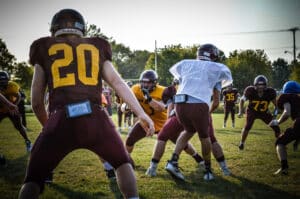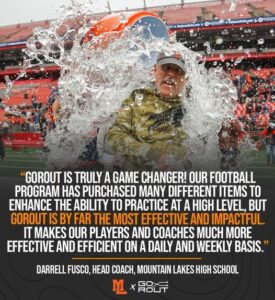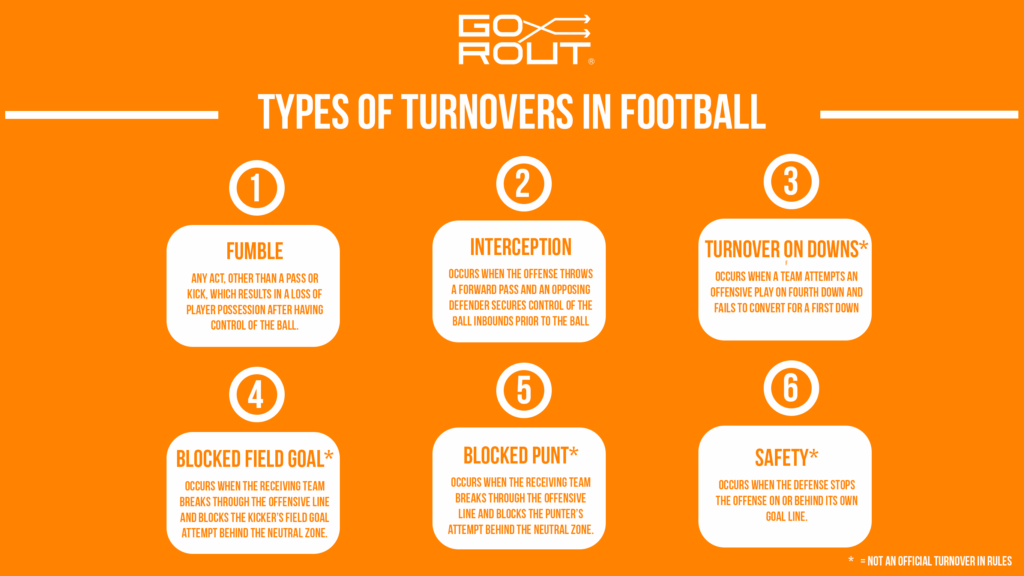8 Football Conditioning Drills to Build Strength and Stamina
Reading Time: 10 minutes
Reading Time: 10 minutes
American football is a game of agility, endurance and strength. To excel on the field, players require peak physical conditioning.
As a coach preparing your team for the season, you know an effective football conditioning plan is essential for winning games.
In this article, we’ll explore eight football-specific conditioning drills for athletic strength and stamina. From agility drills to endurance-building exercises, these techniques will help your players push their limits and dominate the game.
We will also explain how essential football coaching gear and advanced practice solutions, such as GoRout, revolutionize training sessions, elevate football drills, and prepare teams for a winning season.
The Role of Football Conditioning Drills

Football drills improve players’ cardiovascular endurance, strength, agility, and speed, allowing them to sustain high levels of play throughout a game. Well-conditioned players maintain peak performance, execute plays more effectively and recover quickly between intense bursts of activity.
Conditioning drills strengthen muscles, improve joint stability and enhance flexibility, reducing the risk of common injuries like sprains, strains and tears. Squats and deadlifts build the lower body’s resilience, while plyometric exercises boost power and reduce the likelihood of muscle injuries.
Key Components of Football Conditioning Drills
Knowing how to coach football requires maintaining your athletes’ focus, physical condition and work ethic. A great conditioning program has four key components to condition football players and keep them performing well throughout the year.
Strength for power and protection
Strength training brings the power needed for explosive movements and protection against injuries. Exercises like squats, deadlifts and bench presses build muscle mass and strengthen an athlete’s base. These exercises increase core stability and muscle balance, crucial for high-impact plays.
Stamina for sustained performance
Endurance conditioning and stamina training include long-distance, interval, and tempo runs. These drills improve cardiovascular endurance and help players recover quickly between plays. Consistent stamina training sustains energy and maintains player focus on the field.
Agility for quick movements and direction changes
Agility drills allow athletes to change directions quickly and efficiently. Ladder drills, cone drills, and shuttle runs work on footwork, coordination and reaction time. These football conditioning drills simulate game situations where quick changes in direction are necessary to avoid opponents or to cover defensive assignments.
Speed for outrunning opponents
Speed conditioning allows for quickness, so football players sprint rapidly over short distances. Sprint drills like resistance sprints and hill sprints increase top-end speed. Quickness allows players on offense and defense to outpace opponents.
Implementing a Football Conditioning Program
At the beginning of the training week, focus on high-intensity conditioning drills to build strength and power. Midweek sessions should balance moderate-intensity conditioning with skill-focused drills for agility and position-specific training.
Towards the end of the week, taper down to low-intensity activities like stretching to recover and prepare players for game day.
Focus on building a solid fitness foundation with higher volumes of pre-season conditioning, maintaining fitness levels during the season and emphasizing strength and recovery work in the off-season.
Provide safe recovery activities for injured players and position-specific exercises for each role – linebackers, quarterbacks and the offensive line.
Preparing for the Football Conditioning Session
A proper warm-up prepares the body for intense physical activity during football conditioning. Begin with 5-10 minutes of light aerobic exercise to increase blood flow and muscle temperature. Follow with sport-specific drills like high knees, butt kicks and dynamic leg swings to improve the range of motion and activate the muscles.
Ensure all players use appropriate gear and perform exercises with the correct technique to avoid injury. Always include and complete a proper cool-down with static stretching to aid recovery and prevent muscle stiffness.
Track key performance metrics—speed, endurance, strength and agility—through regular testing and assessments. Use this data to set specific, achievable goals for improvement. Review and adjust these goals regularly based on individual player performance and feedback.
8 Football Conditioning Drills to Dominate the Field

Drill 1: High-Intensity Interval Training (HIIT) sprints
HIIT sprints boost cardiovascular fitness and build muscular endurance. Mark out a sprinting distance of 20 to 40 yards on a flat, even surface. To manage intervals, you’ll need a stopwatch or a timer.
Begin with a dynamic warm-up. Sprint at maximum effort for the designated distance, then walk or jog back to the starting point to recover.
Typical intervals involve 30 seconds of sprinting followed by 30 seconds of rest, repeated for 10-15 minutes. Variations include increasing the sprint distance, shortening rest periods or performing uphill sprints to intensify the workout.
Benefits
- Cardiovascular health
- Lower body strength and power
- Increased endurance
Drill 2: Plyometric exercises
Plyometric exercises are explosive movements that increase muscle power and twitchiness.
Some good plyometric conditioning drill exercises include box jumps, burpees, tuck jumps, lateral bounds and jump squats.
You can integrate these exercises into a conditioning routine 2-3 times weekly, after a warm-up and before heavy strength training.
Benefits
- Better muscle strength, power and agility
- Explosive speed for sprinting and jumping
- Quicker direction changes and higher jumps
Drill 3: Agility ladder drills
Agility ladders develop quick, precise movements to navigate the field more effectively, change directions rapidly and improve athleticism.
The one-two-step drill is a great drill for quickness. Other agility ladder drills are hopscotch, grapevine and lateral shuffle.
To keep players engaged, progressively increase the pace of agility ladder drills. Incorporate forward, backward and lateral movements, complex footwork patterns and use timed intervals.
Benefits
- Foot speed
- Coordination and balance
- Change directions quickly and efficiently
Drill 4: Hill sprints
Coaches should choose a hill with a moderate incline and a smooth, even surface to prevent trips and falls. Players warm up thoroughly, lean slightly forward, drive their knees up and pump their arms.
Start with a 10-minute warm-up followed by 6-10 sprints of 20-30 seconds each, with walking recovery between sprints. Gradually increase the number of sprints and finish with a cool-down.
Benefits
- Enhanced leg strength
- Improved power
- Increased cardiovascular endurance
Drill 5: Resistance training with sled pushes/pulls
Resistance training builds muscle strength, power and endurance. It targets key muscle groups – the legs, core and upper body.
Set up sled drills with a weighted sled on a flat, smooth surface. Begin with moderate weights and mark a distance of 20-30 yards for players to push or pull the sled.
To prevent injury, ensure the player’s back remains straight and the core is engaged. Start light and focus on proper pushing/pulling technique before increasing resistance.
Benefits
- Improved leg strength and power
- Enhanced acceleration and deceleration
- Core and upper body strength
Drill 6: Circuit training for football
Tailor the football drill circuit to include game movements like throwing, running and tackling. Include a balanced mix of upper body, lower body and core workouts.
A football-specific circuit could include cone drills for agility, sled pushes for explosive strength, and shuttle runs for speed and endurance.
Adjust the duration of each station. Allow longer rest periods for beginners while shortening them for advanced athletes. Use lighter weights or easier variations of exercises for less fit players.
Benefits
- Improved reaction time and decision-making under fatigue
- Injury prevention
- Boosted teamwork and communication
Drill 7: Position-specific stamina drills
You should customize a stamina drill based on each field position. Linemen require exercises that build strength and short-burst power, while wide receivers need drills that enhance speed, agility and endurance.
Position-specific stamina drills include sled pushes for linemen, cone drills with sprint intervals for wide receivers and backpedal and sprint drills for defensive backs.
A coach should create a balanced training program with general conditioning for team fitness and position-specific drills to address individuals.
Benefits
- Enhanced game-time endurance
- Functional strength and conditioning
- Athletic versatility in different positions
Drill 8: Endurance runs with a twist
Integrate sprints and cuts into endurance runs to simulate game scenarios. For example, include 10-yard sprints, lateral shuffles and a quick directional change drill during a 3-mile run to keep the team on their toes.
Plan runs with more complex football movements for peak off-season conditioning as fitness improves. These runs should be mixed, alternating between steady pace and intervals with explosive drill actions to build endurance and game stamina.
Benefits
- Enhanced endurance
- Improved agility and quickness
- Mental toughness through mimicking unpredictable game situations
Implementing GoRout Into Football Practice

Football coaches recognize that time is a crucial asset during practice sessions. The GoRout coach-to-player communication system is an innovative solution that streamlines communication, saves time and increases football practice efficiency.
GoRout’s platform includes a web/mobile app and wearable devices for coaches and players to instantly share and access play calls. This system increases practice repetitions and boosts performance by making the exchange of information seamless.
GoRout equipment is the preferred choice for coaches nationwide. It revolutionizes practice routines and simplifies weekly game preparation, helping football teams stay one step ahead of the competition on game day.
Simplified scripting app

Simplify your football practice script and organization with seamless integration of popular play-drawing tools. Our user-friendly web scripting app works with any card drawing software and has features for adding, editing, copying and reordering scripts or cards. Football coaches use the app to effortlessly move plays between periods to save time and enhance preparation for practices and games.
On-field practice app

The on-field football practice app uses GoRout STEEL™ to streamline training sessions by managing the start and end times of football practice plans, organizing practice scripts, and sharing plays via a custom on-field remote. GoRout gives coaches rapid communication with each player with features for on-field formation flipping, one-tap play flagging for instant review and the ability to live-edit cards directly on the field.
Player wearable devices

The GoRout football practice device withstands the rigors of long and demanding football practices. These football wristbands provide a hassle-free experience without the need for setup or WiFi connectivity. Coaches can efficiently distribute play calls by selecting practice groups for quick, targeted communication. Devices offer access to play drawings and position-specific messaging to keep teams focused and well-prepared throughout the football season.
Benefits of the GoRout football practice system

GoRout’s football play-calling system is one of the premier sports communication solutions available today offering numerous benefits to football teams.
- Developed by coaches for coaches: Designed and run by experienced coaches, GoRout provides an advanced solution grounded in firsthand coaching expertise.
- Seamless integration: The system integrates effortlessly with play drawing tools and hand-drawn cards, benefiting both coaches and players.
- Increased efficiency: GoRout boosts practice efficiency by increasing a team’s average reps by 2.5 times, freeing up valuable time for additional coaching and giving players more opportunities to improve.
- Durability: The system delivers reliable performance in any weather conditions – extreme temperatures, humidity, or rain.
- Warranty: GoRout’s comprehensive 100% full-coverage warranty gives users complete confidence in the system’s reliability, security and durability.
- Security: Our devices deliver cutting-edge security, 4-way privacy screens, and market-leading encryption for all communications and private interactions between you and your team.
Experience GoRout football practice to see how it can help lead your team to victory on game day.
Coaches’ testimonials of the GoRout football practice system

Thousands of coaches across the nation use GoRout to boost communication, multiply reps and enhance scout teams. Here are some trusted GoRout testimonials from satisfied football coaches.
CHRIS WILKERSON
“Our football team made a massive improvement from 2 wins in 2022 to 8 wins in 2023, and GoRout was a huge part of our team’s improved performance. It allowed us to be as efficient as possible with our players’ time. We were able to run more plays weekly in practice and cut down on the time we had to be on the field. The team at GoRout was amazing to work with. The quality of their product and customer service are second to none. Our players and coaches love the GoRout product.”
EASTERN ILLINOIS UNIVERSITY | 2024
THOMAS HARVEY
“You can’t go wrong with GoRout. Saves time and energy. You get an assistant coach back who would normally be holding scout cards. It’s like adding another coach to your staff!”
ANDREWS HIGH SCHOOL | 2024
Recovery and Nutrition After Football Conditioning Drills
A proper cool-down and recovery routine reduces muscle soreness and prevents injury after intense football conditioning drills. Consuming a balanced mix of proteins and carbohydrates within 30 minutes post-training can aid muscle repair and replenish glycogen stores. Players should drink plenty of fluids before, during and after sessions to replace lost electrolytes and prevent dehydration.
Monitoring Player Progress and Adjustments
Track conditioning improvements with sports coaching technology like fitness apps, heart rate monitors and performance-tracking software to gather data.
Increase the intensity or complexity of drills when players consistently meet their performance goals and show readiness for more advanced challenges.
During breaks, keep players motivated by setting clear, achievable goals, offering positive reinforcement and reminding them of their progress and the importance of their effort to the team’s success.
Conclusion
Strength and stamina are critical for football players to enhance performance and reduce injuries. There is more than one great drill to help players get in shape and meet a goal.
Football coaches should get creative and adapt conditioning drills to their team’s needs so each player gets what they need out of practice.
A successful conditioning program depends on regularly monitoring progress, adjusting drills as needed and emphasizing recovery and nutrition.
Implementing the GoRout wearable technology in sports streamlines training, enhances communication and keeps players well-informed and engaged.
Get a quote to meet your game-winning goal this football season!
FAQs about Football Conditioning Drills
How to train for football conditioning?
To train for football conditioning, mix aerobic and anaerobic exercises, strength training and agility drills to build endurance and speed. Incorporate recovery practices and a balanced diet for muscle repair and sustained energy.
Check out our youth football playbook.
What is 4 quarters football conditioning?
The “Four Quarters Conditioning Drill” divides a workout into four segments. Each quarter consists of progressively longer sprints with increasing rest intervals: 10-yard sprints (10 seconds rest), 20-yard sprints (20 seconds rest), 30-yard sprints (30 seconds rest) and 40-yard sprints (40 seconds rest).
What is the terrible 20s exercise?
The “Terrible 20s” exercise combines push-ups, sit-ups and sprints. Start with 20 push-ups, then sprint 100 yards and do 20 sit-ups. After each round, you decrease the number of push-ups and sit-ups by one until you reach one rep.
How do you train to hit harder in football?
To train to hit harder in football, athletes use exercises like power cleans, rapid standing band presses and kettlebell swings to deliver powerful hits on the field.







